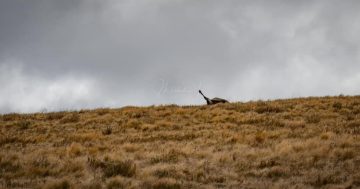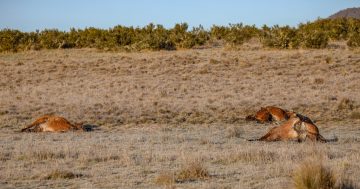
Aerial shooting of wild horses in Kosciuszko National Park is set to begin after today’s announcement by NSW Environment Minister Penny Sharpe. Image: Snowy Brumby Photography Adventures.
The NSW Government has adopted an amendment to the 2021 Kosciuszko National Park Wild Horse Heritage Management Plan (KNP WHHMP), which now authorises aerial shooting as an approved method of reducing the number of wild horses, or brumbies, in the park.
This amendment allows the NSW National Parks and Wildlife Service (NPWS) to use aerial shooting in addition to existing control methods – such as ground shooting, trapping and rehoming – to reach the legally required wild horse population target of 3000 by mid-2027.
The change, according to the government, is essential to protecting the park’s threatened native wildlife and ecosystems.
In 2018, the NSW Threatened Species Scientific Committee determined habitat degradation and loss by wild horses as a key threatening process, identifying more than 30 adversely affected NSW and Commonwealth-listed threatened species and communities.
These include the critically endangered southern and northern corroboree frogs, the endangered Alpine she-oak skink, the vulnerable broad-toothed rat, the critically endangered blue-tongued greenhood, and the critically endangered fish stocky galaxias.
Soil, waterways and limestone caves are also under threat, according to the government.
A November 2022 survey of wild horses in Kosciuszko National Park (KNP) showed an estimated population of 18,814, with a 95 per cent confidence interval of 14,501 to 23,535 wild horses.
This showed an increase on a 2020 survey, which estimated the population at 14,380 and raised the ire of environmental groups that have demanded the government adhere to the KNP WHHMP, which requires the wild horse population to be reduced to 3000.
The remaining horses would be retained in 32 per cent of the park to protect their heritage value.
The NSW Government has confirmed the amendment to the plan does not change this requirement.

Under the Kosciuszko National Park Wild Horse Heritage Management Plan, the wild horse population is to be reduced to 3000, with heritage breeds to be retained in 32 per cent of the park. Image: Snowy Brumby Photography Adventures.
The proposal to amend the KNP WHHMP was put on exhibition for community input and attracted 11,002 submissions.
Advice from the Wild Horse Community Advisory Panel and NPWS Advisory Council was also considered.
Of the submissions that commented on aerial shooting, 82 per cent expressed support for the control method being included in the plan.
Following careful consideration of these submissions, NSW Minister for the Environment Penny Sharpe said she determined the amendment necessary to help save endangered and vulnerable species and their habitat, protect soil and waterways and conserve cultural heritage.
As part of the decision, the NSW Government is releasing a summary of submissions, available on the NSW Department of Planning and Environment website.
The Minister also noted the recent Senate Environment and Communications References Committee Report which found effective control of wild horses could be the difference between survival and extinction for up to a dozen threatened species found only in the Australian Alps.
“There are simply too many wild horses in Kosciuszko National Park,” Senator Sharpe said. “Threatened native species are in danger of extinction and the entire ecosystem is under threat. We must take action.”
She said she wanted to make sure NSW NPWS staff had all the options they needed to reach the population target and protect this precious alpine environment.
“This was not an easy decision. No one wants to have to kill wild horses. I have carefully considered all the options, and I thank everyone who took the time to make a submission,” Ms Sharpe said.
The Minister said the NPWS would undertake a short, preliminary program that would refine the standard operating procedure for aerial shooting in Kosciuszko National Park.
This preliminary program has been developed with input from an independent wildlife veterinarian and RSPCA NSW, which will observe and evaluate.
The Minister’s office would not confirm when shooting was to commence, but warnings and signage have already been posted publicly warning park users of the NPWS’ intentions to conduct aerial pest control shooting operations in some parts of the park.
The signage indicates listed areas will be closed for up to four days between 7 am, Monday 13 November and 7 pm, Friday 24 November 2023 (excluding weekends).
A Review of environmental factors and a carcass management plan is also set to be finalised and released following the preliminary aerial shooting program.
The carcass management plan will take into account issues raised by stakeholders and an environmental assessment, in consultation with the Environment Protection Authority (EPA) and will be subject to ongoing refinement, as required.
In the meantime, the Minister has offered assurances carcasses will not be left in or close to major waterways or within 400 metres of busy visitor areas such as campgrounds.
Carcasses will be moved if necessary to meet the requirements of the carcass management plan, she said.
The Minister says NSW NPWS staff are highly trained and undergo rigorous testing to be approved to carry out aerial shooting on a range of invasive species, including deer and pigs.
“Aerial shooting, when carried out by highly trained personnel in accordance with rigorous standards, delivers the best possible animal welfare outcomes,” she said.
“I know this decision will upset some members of the community. I empathise with those who feel distressed that we must undertake control programs. My commitment is that I will always be open and honest with the community about these matters, without risking safety to visitors and staff.”
The Minister also confirmed a 2023 wild horse population survey undertaken in October will be peer-reviewed and made publicly available.
The count methodology used to determine the wild horse population has been challenged by independent statisticians and has led to the establishment of an upcoming NSW Upper House inquiry into the proposed aerial shooting of brumbies in KNP.
The nine terms of reference include an examination of the methodology used to survey and estimate the brumby population in KNP, justification of aerial shooting for controlling numbers of brumbies in KNP, status of threatened species, impacts of aerial shooting, animal and public welfare concerns, and investigations into the history and impact of previous aerial shooting operations.
A date is yet to be set for that inquiry but when submissions closed on 13 October, 165 had been received.
Original Article published by Edwina Mason on About Regional.




















